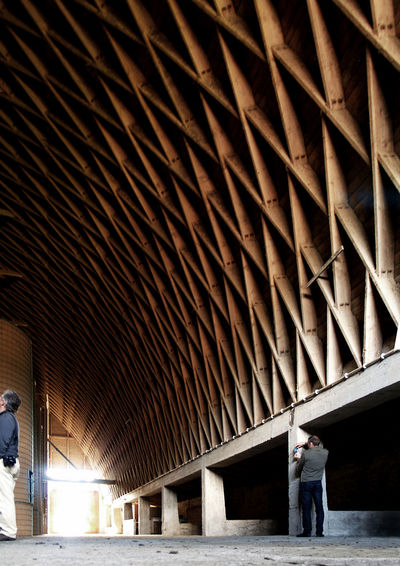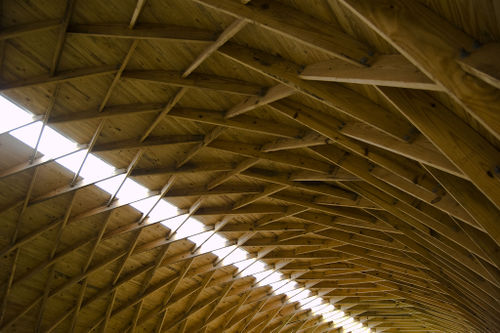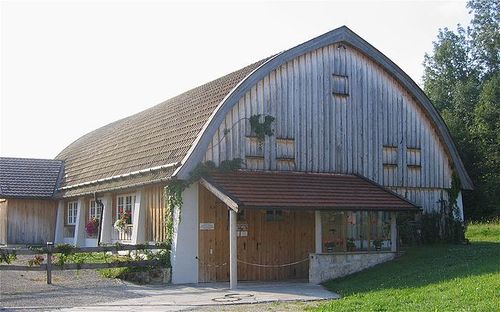Lamella Roof: Difference between revisions
m (inserted categorization) |
(inserted another image) |
||
| Line 1: | Line 1: | ||
[[File: LamellaRoof1.jpg |400px|thumb|right|Lamella | [[File: LamellaRoof1.jpg |400px|thumb|right|Lamella roof: barn interior, Gut Garkau farm, Germany, 1923-1926. Architect: Hugo Häring, 1882-1958.]] | ||
A lamella roof is a vaulted roof made up of simple, single prefabricated | A lamella roof is a vaulted roof made up of simple, single prefabricated standard segments as a way to span large spaces. The individual pieces are joined together with bolts and/or plates to form a rhomboid pattern. These elements were mostly in timber but sometimes in steel. A wooden sheathing covers the structure on the outside. | ||
The lamella roof was patented in 1910 and became popular between the World Wars, especially in Germany when metal for construction was in short supply. | The lamella roof was patented in 1910 and became popular between the World Wars, especially in Germany when metal for construction was in short supply. Some of these structures are now almost 100 years old and often remain in very good condition. In the 1950s, this concept was adapted in the U.S. to the construction of large dome structures by architect Gustel Kiewitt. | ||
[[File: LamellaRoof2.jpg |500px|thumb|left|Lamella roof: Hale County Animal Shelter (Auburn University's Rural Studio Project)]] | |||
[[File: LamellaRoof3.jpg |500px|thumb|center| Exterior view of a barn with lamella roof.]] | |||
==DIY== | |||
These roofs are very easy to build, inexpensive and elegant. The wooden segments are short and therefore easy to mass-produce. Local wood can be used. An extensive temporary scaffolding is not needed. | |||
==Old Patents== | |||
* US Patent 1483037 (1924) [http://www.google.com/patents/US1483037 "MANUFACTURING SPACE-COVERING STRUCTURES SUCH AS ROOFS, FRAME WALLS, AND THE LIKE"] | |||
* US patent 1753892 (1930) [http://www.google.ca/patents/US1753892 "Space-covering structure, such as roofs, walls, and the like"] | |||
==Links== | ==Links== | ||
* Wikipedia (Ger.): [https://de.wikipedia.org/wiki/Zollingerdach "Zollingerdach"] | * Wikipedia (Ger.): [https://de.wikipedia.org/wiki/Zollingerdach "Zollingerdach"] | ||
[[Category:Housing and construction]] | [[Category:Housing and construction]] | ||
Revision as of 02:48, 6 July 2016
A lamella roof is a vaulted roof made up of simple, single prefabricated standard segments as a way to span large spaces. The individual pieces are joined together with bolts and/or plates to form a rhomboid pattern. These elements were mostly in timber but sometimes in steel. A wooden sheathing covers the structure on the outside. The lamella roof was patented in 1910 and became popular between the World Wars, especially in Germany when metal for construction was in short supply. Some of these structures are now almost 100 years old and often remain in very good condition. In the 1950s, this concept was adapted in the U.S. to the construction of large dome structures by architect Gustel Kiewitt.
DIY
These roofs are very easy to build, inexpensive and elegant. The wooden segments are short and therefore easy to mass-produce. Local wood can be used. An extensive temporary scaffolding is not needed.
Old Patents
- US Patent 1483037 (1924) "MANUFACTURING SPACE-COVERING STRUCTURES SUCH AS ROOFS, FRAME WALLS, AND THE LIKE"
- US patent 1753892 (1930) "Space-covering structure, such as roofs, walls, and the like"
Links
- Wikipedia (Ger.): "Zollingerdach"


